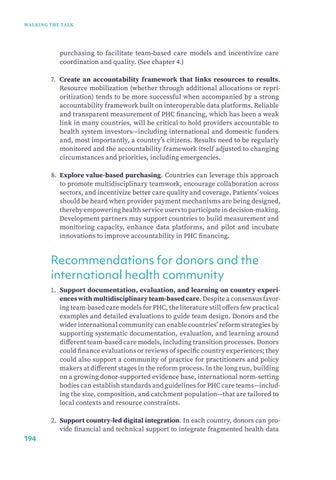WALKING THE TALK
purchasing to facilitate team-based care models and incentivize care coordination and quality. (See chapter 4.) 7. Create an accountability framework that links resources to results. Resource mobilization (whether through additional allocations or reprioritization) tends to be more successful when accompanied by a strong accountability framework built on interoperable data platforms. Reliable and transparent measurement of PHC financing, which has been a weak link in many countries, will be critical to hold providers accountable to health system investors—including international and domestic funders and, most importantly, a country’s citizens. Results need to be regularly monitored and the accountability framework itself adjusted to changing circumstances and priorities, including emergencies. 8. Explore value-based purchasing. Countries can leverage this approach to promote multidisciplinary teamwork, encourage collaboration across sectors, and incentivize better care quality and coverage. Patients’ voices should be heard when provider payment mechanisms are being designed, thereby empowering health service users to participate in decision-making. Development partners may support countries to build measurement and monitoring capacity, enhance data platforms, and pilot and incubate innovations to improve accountability in PHC financing.
Recommendations for donors and the international health community 1. Support documentation, evaluation, and learning on country experiences with multidisciplinary team-based care. Despite a consensus favoring team-based care models for PHC, the literature still offers few practical examples and detailed evaluations to guide team design. Donors and the wider international community can enable countries’ reform strategies by supporting systematic documentation, evaluation, and learning around different team-based care models, including transition processes. Donors could finance evaluations or reviews of specific country experiences; they could also support a community of practice for practitioners and policy makers at different stages in the reform process. In the long run, building on a growing donor-supported evidence base, international norm-setting bodies can establish standards and guidelines for PHC care teams—including the size, composition, and catchment population—that are tailored to local contexts and resource constraints. 2. Support country-led digital integration. In each country, donors can provide financial and technical support to integrate fragmented health data 194


